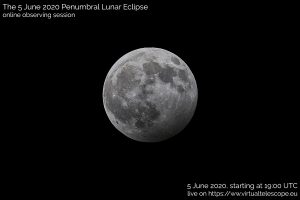On June 5, 2020, the Moon will offer us another penumbral lunar eclipse. While not so spectacular as a partial or total lunar eclipse, it will be a nice natural show to see. And the team at Virtual Telescope will be sharing it live, online, showcasing the Moon above the skyline of Rome.
Since the penumbral lunar eclipse will not be viewable from North America, the Virtual Telescope live stream will provide a nice opportunity to virtually experience the eclipse. And enhanced views from the Virtual Telescope advanced equipment will provide an up close, intimate experience.
 The Virtual Telescope Project is a service provided by the Bellatrix Astronomical Observatory in Italy and is managed by Dr. Gianluca Masi, PhD. The observatory complex consists of several robotic telescopes, which are remotely accessible in real-time over the Internet. The telescopes are available to the public for research and amateur astronomy.
The Virtual Telescope Project is a service provided by the Bellatrix Astronomical Observatory in Italy and is managed by Dr. Gianluca Masi, PhD. The observatory complex consists of several robotic telescopes, which are remotely accessible in real-time over the Internet. The telescopes are available to the public for research and amateur astronomy.
A penumbral lunar eclipse occurs when the Sun, Earth, and the Moon are not in total alignment. Consequently, the Earth blocks just some, but not all of the Sun’s light from reaching the Moon and covers all or part of the Moon with the lighter outer part of its shadow, which is known as the penumbra.
For a penumbral lunar eclipse to occur there must be a full Moon and the Sun, Earth, and Moon must be nearly aligned, but not as closely aligned as during a partial eclipse.
About one in three of all lunar eclipses are penumbral. It can be impossible to observe the start and end of a penumbral lunar eclipse, even with telescopes. Penumbral eclipses that involve the darker portion of the Earth’s penumbral shadow, however, can be visible to the naked eye.
To plan out this and other future astronomical events, you might want to consider downloading AstroGadgets, a free Windows desktop program that gathers information from various astronomy websites. The software provides a concise display of essential information and provides pop-up, audible, email or SMS (text message) alerts for events such as eclipses, International Space Station passes and Planetary KP Index levels (conditions favoring aurora).

